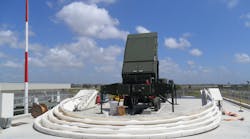UPDATE: MEADS Radar Performs 360-Deg. Rotation For Missile Tracking
UPDATE: A six-week performance test was recently completed on the MEADS’ MFCR where it successfully demonstrated several capabilities including tracking and cancelling jamming signals, searching, cueing, and tracking in ground clutter, and classifying target data using kinematic information. The testing occurred at Pratica di Mare Air Base near Rome, Italy, and at MBDA Germany's air defense center in Freinhausen—marking the first time the MFCR has been operated in Germany.
PREVIOUSLY: To provide system capabilities not met by current air and missile defense systems, the Medium Extended Air Defense System (MEADS) is being developed to meet International Common Operational Requirements. To enable coverage with no blind spots, this next-generation system incorporates netted and distributed battle management, easily transportable launchers, a PAC-3 missile, and 360-deg. radar capability. As part of a recent demonstration, the MEADS Multifunction Fire Control Radar (MFCR) acquired and tracked a live tactical ballistic missile (TBM) for the first time. The system also was tested for its ability to intercept and destroy two simultaneous targets attacking from opposite directions.
Both presentations were completed at the White Sands Missile Range in New Mexico. The first demonstration showcased the radar positively detecting the missile shortly after launch. It maintained dedicated track mode until shortly before ground impact. The MEADS MFCR is a 360-deg., X-band, solid-state, active electronically steered array (AESA) radar. It can provide tracking capabilities against highly maneuverable, low-signature threats including short- and medium-range ballistic and cruise missiles and other air-breathing threats.
The second test put all MEADS system elements to work including the surveillance radar, a networked MEADS battle manager, two lightweight launchers firing the missiles, and the MFCR. A QF-4 air-breathing target approached from the south as a Lance missile attacked from the north. The surveillance radar successfully acquired both targets and provided cues to the MEADS battle manager, which generated cue commands for the MFCR. The MFCR then tracked both targets and guided missiles from launchers in the Italian and German configurations to intercept them.
To provide enhanced operational flexibility, MEADS’ netted-distributed architecture utilizes distributed sensors, launches, and tactical operations centers (TOCs). Its “plug-and-fight” capability enables all of the sensors, shooters, and other TOCs to act as nodes within the MEADS network. From there, a commander can dynamically add or subtract elements without shutting the entire system down. That flexibility—in conjunction with the radar’s 360-deg. Tracking—reportedly allows MEADS to defend up to eight times the coverage area with far fewer system assets compared to previous approaches.
